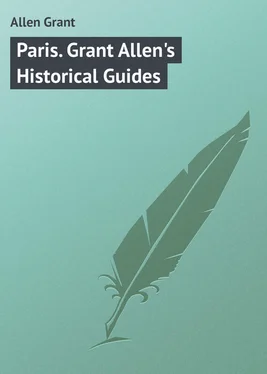Grant Allen - Paris. Grant Allen's Historical Guides
Здесь есть возможность читать онлайн «Grant Allen - Paris. Grant Allen's Historical Guides» — ознакомительный отрывок электронной книги совершенно бесплатно, а после прочтения отрывка купить полную версию. В некоторых случаях можно слушать аудио, скачать через торрент в формате fb2 и присутствует краткое содержание. ISBN: , Издательство: Иностранный паблик, Жанр: foreign_language, foreign_prose, на английском языке. Описание произведения, (предисловие) а так же отзывы посетителей доступны на портале библиотеки ЛибКат.
- Название:Paris. Grant Allen's Historical Guides
- Автор:
- Издательство:Иностранный паблик
- Жанр:
- Год:неизвестен
- ISBN:http://www.gutenberg.org/ebooks/49907
- Рейтинг книги:4 / 5. Голосов: 1
-
Избранное:Добавить в избранное
- Отзывы:
-
Ваша оценка:
- 80
- 1
- 2
- 3
- 4
- 5
Paris. Grant Allen's Historical Guides: краткое содержание, описание и аннотация
Предлагаем к чтению аннотацию, описание, краткое содержание или предисловие (зависит от того, что написал сам автор книги «Paris. Grant Allen's Historical Guides»). Если вы не нашли необходимую информацию о книге — напишите в комментариях, мы постараемся отыскать её.
Paris. Grant Allen's Historical Guides — читать онлайн ознакомительный отрывок
Ниже представлен текст книги, разбитый по страницам. Система сохранения места последней прочитанной страницы, позволяет с удобством читать онлайн бесплатно книгу «Paris. Grant Allen's Historical Guides», без необходимости каждый раз заново искать на чём Вы остановились. Поставьте закладку, и сможете в любой момент перейти на страницу, на которой закончили чтение.
Интервал:
Закладка:
Room III. – A long corridor. Wall A, is entirely occupied by the **magnificent suite of six early French tapestries, known as “The Lady and the Unicorn” (symbol of chastity), the finest work of its sort ever executed. They come from the Château de Boussac, and belong to the second half of the 15th century. The Lady is represented engaged in various domestic pursuits of a woman of rank of her time, always accompanied by the beast of chastity. The colour is inexpressibly lovely. Above it, similar tapestry representing the History of St. Stephen, and the Discovery of his Relics. Along Wall A, R of entrance door (774), crowned wooden figure of St. Catherine, holding the sword of her martyrdom, her broken wheel at her feet, and trampling upon the tyrant, Maximian. L of door, good early Madonna and Child; another St. Catherine; and (760) Magdalen, described (erroneously, I think) as Pandora. Wall Bis mostly occupied by a handsome French Renaissance chimney-piece (16th century), brought here from a house at Rouen, and representing the history of the Casa Santa at Loreto, – its transport over the sea by angels, its reception by the Faithful, and worship in front of it. The ceiling above also comes from the same room. Wall C, small stained-glass windows of various ages. Examine them separately. Wall D, large enamelled plaques brought from François Premier’s Château of Madrid, in the Bois de Boulogne, stated to be the largest enamels in existence. Beneath them, fine wooden statue of the Virgin and infant Christ, German 15th century, very characteristic in its flat features, as well as in the dress, and treatment of the hair, of the German style of the period. Compare it with French Madonnas below. The screenstowards Wall Acontain specimens of fine Renaissance wood-carving. Contrast the finish and style of these with their Gothic predecessors. Notice, near the chimney-piece (828), an Annunciation, with God the Father, wearing a triple crown (like the Pope), and the Holy Spirit descending upon the Madonna. Next screen, various classical scenes in the taste of the Renaissance – Judgment of Paris, Venuses and Cupids, etc. Much fine nude Renaissance detail. Centre case, old glass; notice, in particular (4763), fine 13th century Arab mosque-lamp. Further on, more Renaissance wood-carving – Leda and the Swan in very high relief: low reliefs of classical subjects and decorative panels. All these works should be closely studied as typically illustrative of Renaissance feeling. Cases by the window (wall C), Limoges and other enamels, too numerous to treat in full detail, but many of them, at least, should be closely inspected and comprehended by the visitor. Case nextthe chimney-piece, old raised enamels (12th and 13th centuries), enamelled gold reliquaries for containing bones of Saints; fine crucifix, etc. Notice on 4497, the Flight into Egypt, Peter walking on the Sea, the Adoration of the Magi, and the Presentation in the Temple; on 4498, the Crucifixion, and the Twelve Apostles; beneath, 4514, enamelled book-cover; near it, Crucifixion, Adoration of the Magi, and other figures. Identify as many of these as possible, and observe their archaic striving after effects too high for the artist. Second case: Limoges enamels, more modern in type (15th century): Madonna holding the dead Christ, Crucifixion, Bearing of the Cross, and other scenes. Notice particularly (4575), little triptych with a Nativity, Adoration of the Magi, and Circumcision, in all of which observe the conventional treatment. Third case: Limoges enamels of the High Renaissance (16th and 17th centuries), Raphaelesque in spirit, better in execution, but far less interesting; good portraits in frames; a fine Flagellation, and other scenes from the Passion; above, delicate Tazzas. Observe in particular (4628), the Descent into Hell, Christ rescuing Adam and Eve and the other dead from Hades, typically Renaissance. On the far side of the case, remote from window, a good series of the Gospel history, – Marriage of the Virgin, Annunciation, Birth of the Virgin (incorrectly labelled Nativity), etc. Last cases: more recent enamels. Among the best are, in the last case of all, the Expulsion from Paradise, and a series of the Gospel History; observe particularly (4650), Christ and the Magdalen, with the usual curious disguise as a gardener. I recommend to those who can spare the time, most attentive detailed study of the subjects and treatment in all these enamels, many of which throw much light on similar themes treated by other arts in the same collection. Several hours should, if possible, be devoted to them.
Room IV contains various **Mohammedan potteries, exquisitely decorative, but (owing to the general absence of figure subjects, prohibited by Islam) requiring comparatively little explanation. Occasional animal forms, however, occur in the midst of the usually decorative arabesque patterns. Wall C, L of entrance, charming Rhodian pottery (made by Persian workmen), in prevailing tones of blue and green, with the wonderful Persian feeling for colour. Wall B, Hispano-Moorish lustre ware, the most exquisitely beautiful ever manufactured. The second case contains several lovely specimens. Wall A, Rhodian ware again. Wall D, Persian. The reader must examine these minutely for himself. It is impossible to do more than point out their beauty.
Room V. — Jewishworks of art of the Middle Ages, interesting as showing the wealth and artistic taste of the mediæeval Hebrews – phylacteries, seven-branched candlesticks, goldsmiths’ work, etc. (188) Chimney-piece (Christian) from an old house at Le Mans. The groups represent the three ages of life: right and left, the two sexes – man, armed; woman, with a ball of wool.
Room VI. — Wall C, opposite windows, carved chest (1360), French, 17th century, with figures in high relief of the Twelve Apostles. The paintings above it (1704, 1707, 1714), etc., are the fronts of similar chests, Florentine, 15th century. Such boxes were commonly given to a bride to contain her trousseau and household linen. For instance, one (1710) contains the mythical history of a betrothal and wedding (Æneas and Lavinia). The others have in many cases similar appropriate subjects from classical story. (1455) Florentine mosaic cabinet, in the worst taste. Beyond it, other cabinets and fronts of wedding chests. This room also contains musical instruments, interesting as illustrating the evolution of modern forms. Also, florid Italian inlaid tables, in the bad expensive taste of the 17th century. In the windows, stained glass.
Room VII. – Carved oak cabinets. (1435) Good Flemish work of the 17th century.
Room VIII. – (189) Carved chimney-piece, similar to that in the Jewish room, and from the same house; marriage scene, allegorical. Carved wooden cabinets and portals, all interesting, but requiring little description. (1431) Again the favourite Renaissance device of Actæon and Diana. Carved oak bed, of age of François Ier, with hangings of the same period. (1509) Good panel of a chair, with the Presentation of the Virgin in the Temple by Saints Joachim and Anna; above, Nativity; then Adoration of the Magi, and Flight into Egypt; on the front, patron saints of the owners.
Room IX.— **Magnificent collection of ivories and ebonies, all of which the spectator should examine in detail. Nothing in this museum is more interesting. Notice, for example, the beautiful triptych **(1081) in the centre of the first caseby the window of Wall D; lower tier, Annunciation; Shepherds; Joseph and the Madonna, with the babe in the manger; and Adoration of the Magi; upper tier, Kiss of Judas, Crucifixion, and Christ and the Magdalen in the Garden; beautiful Italian work of the 14th century. L of it **(1088), exquisite coloured triptych with Madonna and Child; L, St. Paul (with his sword) and St. Catherine; R, St. Peter and the Magdalen; notice their symbols. Several small ivories in the same case should be observed carefully. Below the large triptych, for example, are scenes from the Passion ( not chronologically arranged in their existing order), namely, from L to R, Crown of Thorns, Scourging, Resurrection, Ascension, Disciples at Emmaus, Apparition to the three Marys, Peter on the Sea, and Christ with the Magdalen; very naïve French work of the 15th century. (718) Exquisite little wood-carving of the Crucifixion, with scenes from the Passion; Spanish, 16th century. Above it (7227), comb, with Adoration of the Magi; 14th century, very curious. The next casecontains still earlier and more interesting work. In the centre, a triptych; lower tier, Adoration of the Magi, Madonna with angels, Presentation in the Temple; upper tier, Bearing the Cross, Crucifixion, and Descent from the Cross; exquisite French work, in high relief, of the 14th century. L of it (1082), Scenes from the Passion, Last Supper, Agony in the Garden, Kiss of Judas (with Peter cutting off Malchus’s ear), Flagellation, etc. Each compartment here consists of two subjects, which identify; charming French work of the 14th century. Above it (1085 and 1086), secular scenes, life in a garden – 14th century. R of the triptych (1065, 1063, 1066, 1064), legends of saints; St. Denis beheaded and bearing his head; Flagellation of an unknown Martyr, who takes it most comfortably; St. Peter, crucified, head downward; and other episodes – charming French 14th century work. Examine all the pieces in this case carefully. In the first case, towards the centre of the room, early ivory-carvings, a *consular diptych of the 5th or 6th century, very interesting; and other works still displaying classical influence. (1035) Byzantine, Christ and Saints. (1049) Death of the Virgin; fine work showing Byzantine influence; 12th century. (1054) Extremely rude Northern 11th century ivory, representing scriptural scenes, mingled with decorative animals treated in withy-band fashion. (1038) Fine Italo-Byzantine plaque with Crucifixion and Saints, the name of each inscribed beside him. Central case:Ivory statuettes, all deserving close attention. (1032) Antique Roman goddess. (1037) Fine early French Madonna; 10th century. Behind her (1052), beautiful ivory reliquary, French, 12th century, with figures of Saints; L, the personages of the Adoration ( i. e. , the Three Kings) bearing their gifts, and with their names inscribed above them; R, the personages of the Presentation – Madonna, Joseph, Simeon. Further side (1060), beautiful coloured ivory coffer, 14th century, with numerous scriptural scenes, easily recognisable; identify them. Inspect also the ebony cabinets, of which 1458, time of Henri IV. with classical scenes, is a magnificent Renaissance example. By Wall A, more ebony cabinetsand carvings, and exquisite ivory statuettes, of later date, among which notice particularly (1141) a Portuguese Madonna; (1163) a Spanish St. Peter; (1164) Spanish St. Antony of Padua; and (1167) a very curious Peruvian Good Shepherd, showing distinct traces of native art, influenced by introduced Spanish feeling. Further to the R, good classical figures of the later Renaissance. I have only indicated a few of the most interesting among these exquisite carvings; but many hours may be devoted to this room, by those who can afford the time, with great advantage.
Читать дальшеИнтервал:
Закладка:
Похожие книги на «Paris. Grant Allen's Historical Guides»
Представляем Вашему вниманию похожие книги на «Paris. Grant Allen's Historical Guides» списком для выбора. Мы отобрали схожую по названию и смыслу литературу в надежде предоставить читателям больше вариантов отыскать новые, интересные, ещё непрочитанные произведения.
Обсуждение, отзывы о книге «Paris. Grant Allen's Historical Guides» и просто собственные мнения читателей. Оставьте ваши комментарии, напишите, что Вы думаете о произведении, его смысле или главных героях. Укажите что конкретно понравилось, а что нет, и почему Вы так считаете.












